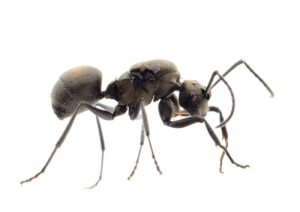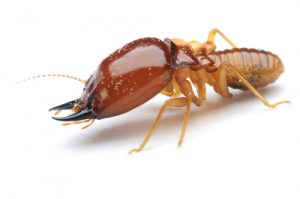Who Damaged This Wood?
By Chris Williams on May 10, 2011.
Q. While installing a washing machine in our basement, we tore off a piece of wood trim and could see from the back side that something had been chewing in there and had mostly hollowed out the piece of wood. None of the other wood looks damaged but we don’t really know how to check. My husband is sure we have termites but aren’t there other insects that cause similar damage?
A. In your case, the two prime suspects are carpenter ants or termites. Both carpenter ants and subterranean termites live in and damage wood. Termites actually eat and digest the wood while carpenter ants just excavate the wood for nest sites. Both prefer moist, soft wood that has been weakened by decay but they can also infest sound, dry wood. While only a pest control professional can tell you for sure which pest has caused the damage, here are some clues:
(1) CARPENTER ANTS: There is usually no external evidence of carpenter ant damage on infested wood except for some slit-like openings that the ants use to eject debris from the nest. You will have to break into the wood with a screwdriver to see the damage and galleries. A carpenter ant nest is housed completely inside the wood with no soil connection so there is no soil-like material in the wood galleries. Unlike termite galleries, carpenter ant nest galleries are clean with no mud or sawdust. The walls of the galleries are rounded and very smooth, as if they had been sandpapered.
 “Carpenter Ants Only” Clue: One clue that you are dealing with carpenter ants is the presence of “dump piles.” Carpenter ants push any debris in the nest out of the wood through window-like slits. You might find these piles on the ground directly under a carpenter ant nest. On close examination, the dump consists of pieces of chewed wood that look like sawdust, plus dead ants or pieces of other insects, and debris such as bits of insulation or drywall.
“Carpenter Ants Only” Clue: One clue that you are dealing with carpenter ants is the presence of “dump piles.” Carpenter ants push any debris in the nest out of the wood through window-like slits. You might find these piles on the ground directly under a carpenter ant nest. On close examination, the dump consists of pieces of chewed wood that look like sawdust, plus dead ants or pieces of other insects, and debris such as bits of insulation or drywall.
(2) SUBTERRANEAN TERMITES: The surface of wood infested by termites may have a blistered look or it may appear undamaged. Termites may continue to feed until only a thin outer shell of wood remains. Damaged wood will have a hollow sound when tapped. If you break into the wood, you will see that the wood inside has a honeycombed or layered appearance. This is because termites eat mostly the softer spring wood portion of woods, leaving the band of harder-to-digest summer wood. The galleries will be spotted with yellowish-brown fecal spots that look like dried oatmeal. The galleries often contain a mixture of solid and digested wood and soil. Since termites digest the wood there are no sawdust-like particles in the galleries or on surfaces under the galleries.
“Termites Only” Clue: One clue that you are dealing with termites is the presence of mud tubes. Termites construct shelter tubes of mud that they use as protection while they travel from their nest in the ground to the wood that they are feeding on. The tubes are about 1/4 to 1/2 inch wide and may be seen going up basement walls, or along plumbing, in vertical cracks in the wall, or in any crevices or corners between structural members. You may not be able to find the tubes.
The best advice is to call Colonial today and have one of our experts conduct a thorough inspection to determine what’s infesting your wood and how extensive the damage might be.